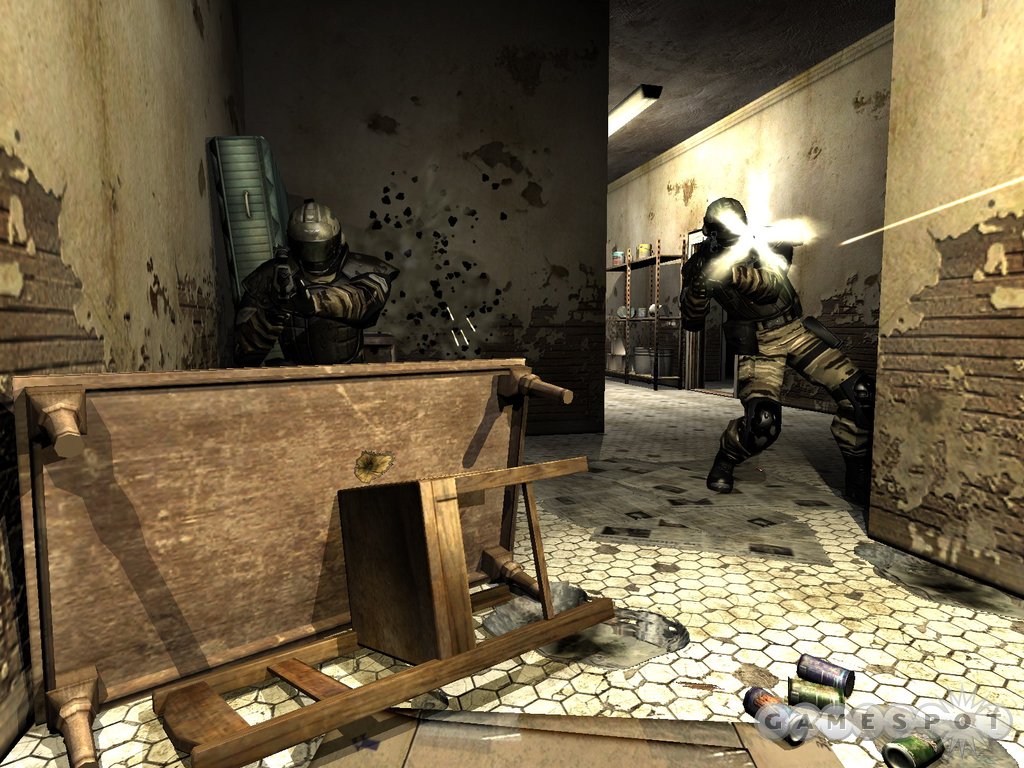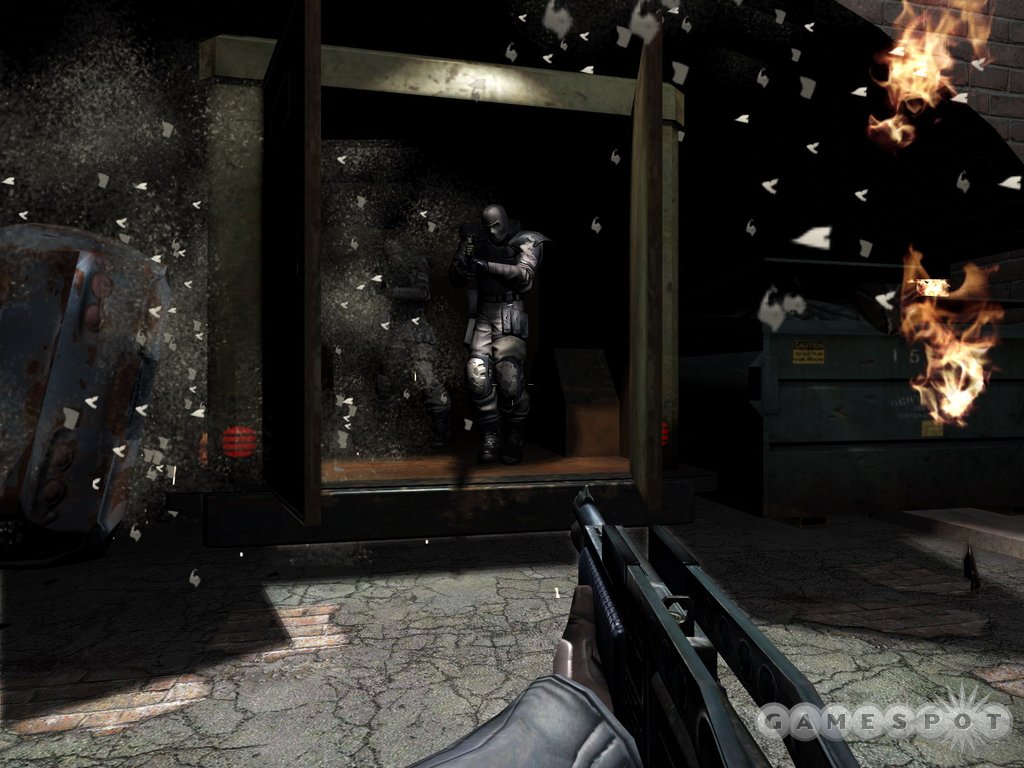F.E.A.R. Q&A - Story, Weapons, Multiplayer
We had tons of questions after getting a chance to play F.E.A.R., and lead designer Craig Hubbard was kind enough to step up to the plate.
Horror has always been a strong element in first-person shooters. For example, in the original Doom you battled demonic creatures from hell. Later shooters, such as Half-Life, resorted to horror movie-style tricks, such as having monsters lunge at you from dark corners. And with the upcoming F.E.A.R., Vivendi Universal Games and Monolith are looking to elevate the horror experience in shooters to a whole new level. The E3 demo of F.E.A.R. last year was a genuinely creepy experience, and this is a game that is inspired by Japanese horror movies, such as The Ring. We recently had a chance to play an early version of F.E.A.R., and the experience left us with more questions than answers. Thankfully, Craig Hubbard, the lead designer and creative director of F.E.A.R., was kind enough to answer our questions.

GameSpot: While we don't want to spoil the game for anyone, including ourselves, we have to ask about at least a few details of the single-player story, especially after seeing the cryptic (and extremely violent) intro movie in March when we were able to play a single-player level. Who are the soldiers wearing blue riot gear that take over the ATC compound? Who is the mysterious corpse-devouring man and why are the soldiers guarding him? And who is the mysterious little girl? Is she the key to everything?
Craig Hubbard: Those are the fundamental mysteries that drive the story! The goal with that opening sequence is to raise dramatic questions that compel you to want to figure out what's going on. I guess its working since you asked all the right questions. What you know at the start of the game is that you're hunting a guy named Paxton Fettel, who you saw in the opening sequence. His motives and intentions are unclear. All you know is a bit of what he's capable of. The rest you'll have to find out on your own.
The trick is that horror is extremely fragile. You can kill it by spelling things out too clearly and you can undermine it with too much ambiguity. The balance I'm trying to strike with the narrative elements of the game is to give you enough clues so that you can form your own theories about what's going on, but ideally you'll be left with some uncertainty, some doubt.
GS: Tell us about the artificial intelligence of the game's enemies? Judging from our recent experience with F.E.A.R. they seem surprisingly skilled at defending themselves against incoming fire and aggressive enough to crawl under tight spots to get at us. What went into creating the AI enemies and what kind of tactics and challenges can we expect from them? And actually, what else can we expect to encounter in the game besides well-trained soldiers?
CH: Our emphasis is on close-quarters combat, so enemy behavior was obviously a major focus. We wanted you to feel like you're fighting trained Special Forces units instead of rank amateurs. The AI is squad-based, meaning that enemies coordinate and communicate with each other as teams rather than individuals. They have pretty extensive environmental awareness, which factors into their navigation and use of cover, even allowing them to create cover by flipping a sofa or knocking over a cabinet to crouch behind. They'll also use hazards against you, so if you duck down next to a fire extinguisher, they'll target it in an attempt to damage you.
You'll encounter various other types of enemies throughout the game. We've already shown the assassins, which are recon units with stealth camo. They're pretty fleet and acrobatic and rely on hand-to-hand attacks. We've also shown heavy-armor soldiers, who use heavier weapons and can take a lot of punishment.
GS: Tell us about why the team decided to go with the weapon selection and weapon modeling that's in the game now. Would you say the fast-firing weapons will appeal to hardcore military enthusiasts or to arcade-shooter fans that are used to having guns that come in neon green? Was choosing an arsenal of real-world weapons that handle pretty unrealistically a decision to try to re-create the feel of an action movie rather than a military simulation?
CH: The goal from the start was to come up with a balanced arsenal where each weapon serves a specific function rather than just going with a bunch of real-world submachine guns and assault rifles. There's nothing wrong with a strictly realistic approach, but as you guessed, we're much more interested in action-movie reality than CNN reality. I'd say we cut the difference between arcade shooters and hardcore simulations closer on the spectrum to Call of Duty than Unreal Tournament or Rainbow Six.

Each weapon has different accuracy, rate of fire, damage, armor penetration, movement penalties, effective range, magazine capacity, etc., so the fact that you can only carry three weapons at a time forces you to make tactical decisions based on the types of situations and enemies you're anticipating. For instance, the submachine gun has a high rate of fire, decent accuracy, and moderate damage, whereas the assault rifle has better range and superior stopping power. There are also a couple of speculative weapons, such as the missile launcher and battle cannon, which are actually variants of Shogo's Bullgut and Shredder.
Horror in Slow Motion
GS: Tell us about the implementation of the slow-motion ability in both single-player and multiplayer. How was this powerful ability balanced? In your testing of the game, is it more useful as a defensive tactic to help players dodge bullets, or are there other specific strategies for it that you've seen in the game?

CH: In single-player, slow mo works on a meter that you can increase over the course of the game. You can activate and deactivate it at will, which allows you to use it very specifically and tactically. We're balancing the game a little bit on the hard side at normal difficulty so that slow mo will have tangible value. You're a lot faster than enemies while in slow mo, so you have a huge advantage for those few seconds.
In multiplayer, we decided to go with a power up-driven approach for a couple of reasons. First, we wanted to limit how often slow mo can be activated to prevent it from becoming annoying. For the same reason, we wanted the duration to be predictable, so that it's not toggling on and off seemingly at random. Also, we wanted it to become an element of gameplay that players would fight over. We're planning to give you a score bonus if you kill an enemy after activating slow mo to add some incentive for holding onto it.
GS: Give us an update on the game's multiplayer. The last time we checked, multiplayer was focused almost entirely on head-to-head deathmatches and elimination modes based on frags rather than on objective-oriented gameplay like capture-the-flag or capture-and-hold modes. Is this still the case? Why the focus on head-to-head play?
CH: The philosophy was to start with a solid foundation and build upward rather than jumping right into something fancy. Because this is a new franchise, we anticipated a lot of experimentation and iteration to figure out exactly how the game was going to feel and play, so we didn't want to get locked into some elaborate design that might not fit the end product. I think it's more prudent to base your decisions on what the game actually is than what you expect it will be, so I really wanted to have rock-solid deathmatch and team deathmatch first, then add elimination, then see where it makes sense to go from there. Otherwise, we could easily have ended up with a wide variety of modes that nobody wants to play, because we went too far too fast and didn't have time to polish the fundamentals.
Obviously, we'd love to do a ton of modes for the game, but we only want to tackle what we think we can polish. That's as much as I can say for now.
GS: During the development process, the team has obviously played the game many times (for testing purposes, of course). Any cool or unusual stories or examples of unexpected gameplay you'd care to share?
CH: Definitely. We're always talking about "movie moments" that happen to us while play-testing. When you mix Havok physics with a flexible AI system, slow mo, lots of special effects, and the lighting tech we're using, you tend to see a lot of cool stuff that you never could have scripted. It's things like throwing a grenade toward where you think an enemy is waiting in cover and seeing his head come rolling out a few seconds after the explosion. Or being in slow mo and right as an enemy unloads point-blank with a shotgun, you manage to slide under the blast and kick his legs out from underneath him. Also, the fact that you can see your own body and shadow results in some good, unexpected scares.
We've had some interesting bugs, too. There was one where enemies would get attached to each other at weird angles and you'd be attacked by these Lovecraftian-looking masses of limbs. There was another issue where an extra player shadow would show up under certain types of lights. The freaky part is that the shadow would be playing this strange, arms-flailing animation, so it looked like some crazy monster was right behind you.

GS: Give us a general update on the game's status. How far along is it? What parts of the game is the team working on now?
CH: The game has been complete and playable for months, but there's a lot of visual polish and gameplay tuning to do before we ship.
GS: Finally, is there anything else you'd like to add about F.E.A.R.?
CH: I'd rather let the game speak for itself!
GS: Thanks, Craig!
Got a news tip or want to contact us directly? Email news@gamespot.com
Join the conversation